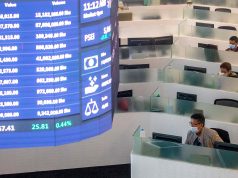Foreign direct investments surge to $573M in February
FOREIGN DIRECT INVESTMENTS (FDI) surged anew in February, supported by strong placements in both debt and equities as players grew more confident about local prospects, the central bank reported yesterday.
FDIs totalled $573 million for the month, spelling a 46.4% increase from the $392 million tallied in February 2017, the Bangko Sentral ng Pilipinas (BSP) said. However, the tally slipped from January’s $919-million net inflow which was the highest in two months.
February inflows soared amid strong interest in equities among foreign investors, resulting in net yields worth $96 million, up 55% from the $62 million in retained capital a year ago.
Gross placements reached $114 million, which was offset by $18 million in outbound funds. These compare to $79 million inflows cancelled out by $17 million in withdrawn capital in April 2017.
Bulk of the investments came from Hong Kong, the United States, China, the Netherlands and Japan. These placements went into art, entertainment and recreation; real estate; manufacturing; construction; and electricity, gas, steam and air-conditioning supply activities, the central bank said.
Meanwhile, bets on debt instruments also soared to $412 million, higher than the $381 million investments received in January and rising by 56.3% from the $264 million received a year prior.
On the other hand, reinvested earnings steadied at $65 million for the second straight month, and went down from $66 million last year.
The two-month FDI tally now stands at $1.493 billion, spelling a 52.6% jump from just $978 million in the comparable period last year.
“The sustained investment inflows reflect investor confidence in the country’s sound macroeconomic fundamentals and growth prospects,” the BSP said in a statement.
Two observers said the foreign investors are particularly bullish about investing in the Philippines in light of medium- to long-term growth prospects.
“I believe the government’s ‘Build, Build, Build’ program and TRAIN have been instrumental in convincing foreign investors that the government’s economic reforms are moving in the right direction and pace,” said Angelo B. Taningco, economist at Security Bank Corp.
“I think both fiscal stimulus and accommodative monetary policy have helped encourage FDIs as both are pro-growth policies.”
The economy expanded by 6.8% during the first quarter led by industry expansion, the Philippine Statistics Authority reported on Thursday. This compares to the government’s 7-8% growth goal, largely supported by P1.068 trillion in infrastructure investments for 2018.
Ruben Carlo O. Asuncion, chief economist at UnionBank of the Philippines, added that the Philippines’ strong fiscal balance, manageable balance of payments, strong domestic consumption growth, and a declining debt burden are boosting investor optimism. He sees the BSP’s $8.2-billion target for 2018 as attainable.
Mr. Taningco even expects FDIs to overshoot the central bank’s projection to hit $10 billion, matching the total in 2017, which was a banner year.
Investments in the Philippines provide additional capital for the local economy, creating more jobs for Filipinos and spurring domestic activity as these fuel business expansions. — Melissa Luz T. Lopez



